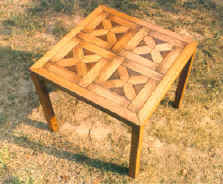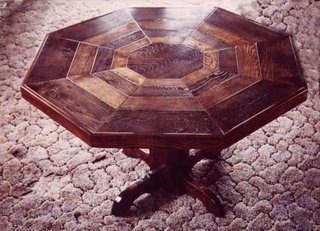Turn Your Hobby Into A Business

by Karen Barnes, IAHBE Staff Writer,
Each year many people earn a living from their hobbies. Hobbies are one of the most under-used income opportunities around. Many people have realized that the skill and imagination they have developed through their hobbies are invaluable to those who appreciate and seek them out. Hobbies range from woodworking to crocheting to fishing to writing. Your hobby is not only relaxing to you but it also can be a source of income when you sell it to other people who are unable to make or find it themselves. With time constraints for many people these days--and the inability to find the time and energy to make these projects or learn these skills themselves--many will pay for such items and services from individuals who have the skill and know-how to produce what others are wanting.
A classic example of a hobby that earns individuals a nice income each year is woodworking. Woodworking projects can range from something as simple as planter boxes to items that are as complicated as furniture pieces. I have known individuals throughout my lifetime that have made a part-time income from building small wooden lawn ornaments and lawn furniture. With their part-time income from their hobby, they have taken trips and cruises that they would normally have been unable to do with their regular paychecks from their jobs. I have known other hobbyists who have not only done the same as the woodworker I mentioned but also have been asked to work on consignment for their pieces. I know of a few ladies who crochet doilies for their pastime who have been asked to crochet doilies and tablecloths for other crafters for their display tables and cases with payment for their services. Bead work is another craft that can be very lucrative. Many beaders find it more lucrative to have their crafts displayed for sale in consignment shops that will take care of the selling part of the hobby. While selling your hobby pieces to those who visit arts and craft shows in your area, consignment shops, and to other crafters are common and popular ways to market your crafts, creating a network of friends and family who have your projects around their homes is also a great way to gain more customers for you. With this type of word-of-mouth advertising, your income earnings could be surprising. If you haven't yet ventured into the sales world with your hobby, you probably have many questions about what you need to know to make this happen. Let's get into this a little bit deeper with some typical, yet simple, questions and answers: 1. Where would you find places to sell your crafts? Arts and Craft Shows--Many communities have Arts and Crafts shows in all seasons by setting up Arts and Craft Fairs at community buildings, such as armories, 4-H buildings, county fair grounds, and any other civic buildings. Check with any local city office for days and times that they are having these shows. The city clerk's office usually will have a list of these events because the sponsors of these shows will have to go there to get permits for holding their events. Check with the sponsors for any fees they may charge, such as booth rent, sign-up fees, deposits, etc. These charges may be tax deductible. Consignment Shops can be found in any of your local telephone books or newspapers. Call or go by these shops and talk to the owners about using their shops to sell your items for you. You will also need to ask the owner how much they charge you for selling your crafts, renting a booth, etc. These charges can be tax deductible. 2. When is the best time of year to sell your crafts? Arts and Crafts shows are mainly held in two seasons. The first season is in the spring when the general public is looking for new home decorating and lawn and garden ideas to revitalize their homes. They may even be looking for summer holidays decorations. The second season is in the fall. In the fall, many are looking for Halloween, Thanksgiving, and Christmas decorations for their homes. Arts and crafts will also be bought for gifts for family, friends, and co-workers. 3. Where can I find materials? There are many places that cater to hobbyists where you can find and purchase your materials. Hobby Lobby, for example, carries a wide variety of materials for every hobby under the sun. Michael's is another large chain with arts and crafts supplies. Think about what craft you are making and search your phone books, newspapers, and the Internet for stores that cater to your specific hobby. 4. When does my hobby qualify as a business and not just a hobby? When you can show that you are making a genuine and professional effort to earn money from your hobby, you can support the claim that it is a business and not just a hobby. To do this, you must keep meticulous records of both your expenditures and your earnings, and you should do everything possible to keep your business monies separate from your personal monies. Supporting evidence that would help the Internal Revenue Service believe that you are really trying to run a business would include business cards, copies of ads or flyers that you have used to promote your business, mileage records and descriptions of the business-related events you have attended, and of course, invoices and customer information for those to whom you have made sales. IMPORTANT: You do not necessarily have to make a profit from your business, but you have to show that you are TRYING to make a profit! Don't let Uncle Sam scare you away from your dream job. When it comes to filing your taxes each year with the IRS, any accountant can help you with the records you need to keep for your tax purposes. As scary as this may sound, this can be the easiest part of turning your hobby into your dream job. There are publications, articles, forms, and much more that can aid you in dealing with your taxes. We have included some excellent links in the "Sources" section below. With the continuation of an unstable economy and loss of jobs, using your hobby as an extra income can help you in many other ways. Use your earnings for your retirement account or to help pay for college tuition...the possibilities are endless! SOURCES Anthony, Joseph. "Your Hobby Should Be A Business: Here's Why." Money Matters BCentral.com. http://www.bcentral.com/articles/anthony/225.asp Godwin, MCC, Leslie. "Should I Turn My Hobby Into A Career?" BusinessKnowHow.com. http://www.businessknowhow.com/homeoffice/hobbycareer.htm IRS Publication 535: "Deducting Business Expenses." http://www.irs.gov/publications/p535/ch01.html IRS Article: "Is It A Business Or A Hobby?" http://www.irs.gov/businesses/small/article/0,,id=99239,00.html SBInfoCanada, About.com. "I Make A Few Bucks From My Hobby. Do I Have To Declare This Income?" http://sbinfocanada.about.com/cs/taxinfo/f/hobbybiz.htm Stern, Linda. "Turning Your Hobby Into A Business." Boston.com http://www.boston.com/business/personalfinance/ articles/2003/09/24/turning_a_hobby_into_a_business/ ~~~~~~~~~~~~~~~~~~~~~~~~~~~~~~~~~~~~~~~~~~~ © Karen Barnes, March, 2004. All rights reserved worldwide. IAHBE Writer ( http://www.moreinfo247.com/93983.939/IAHBE )and SFI Affiliate ( http://www.moreinfo247.com/93983.3101/free ). For more articles like this go to http://articles.1sta.com
Read more!



